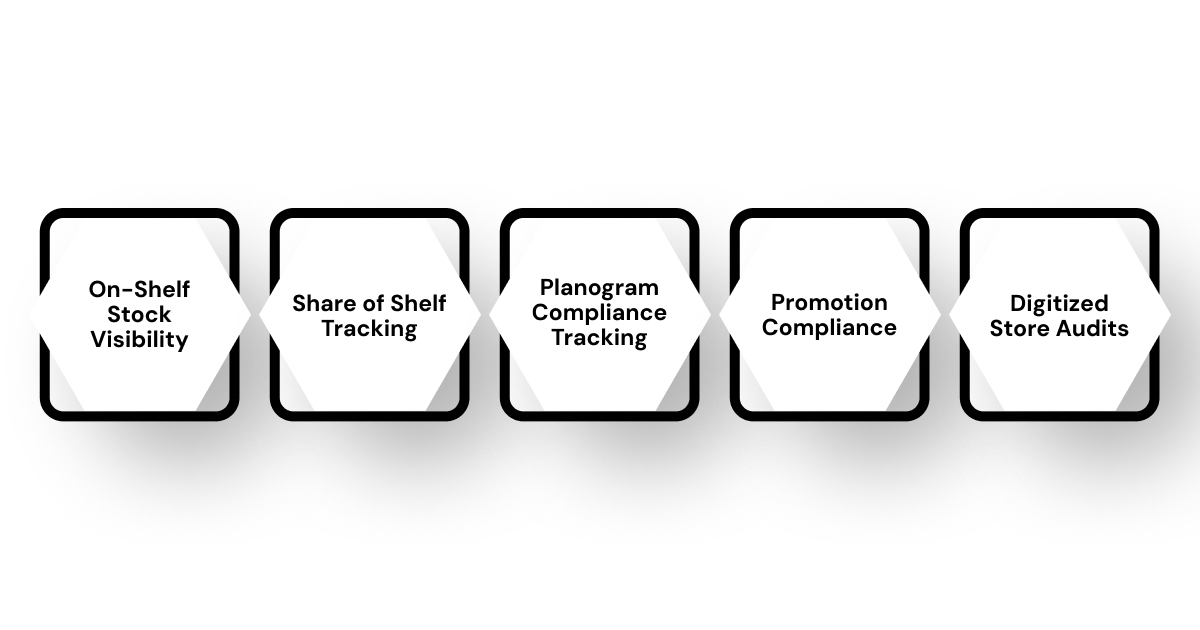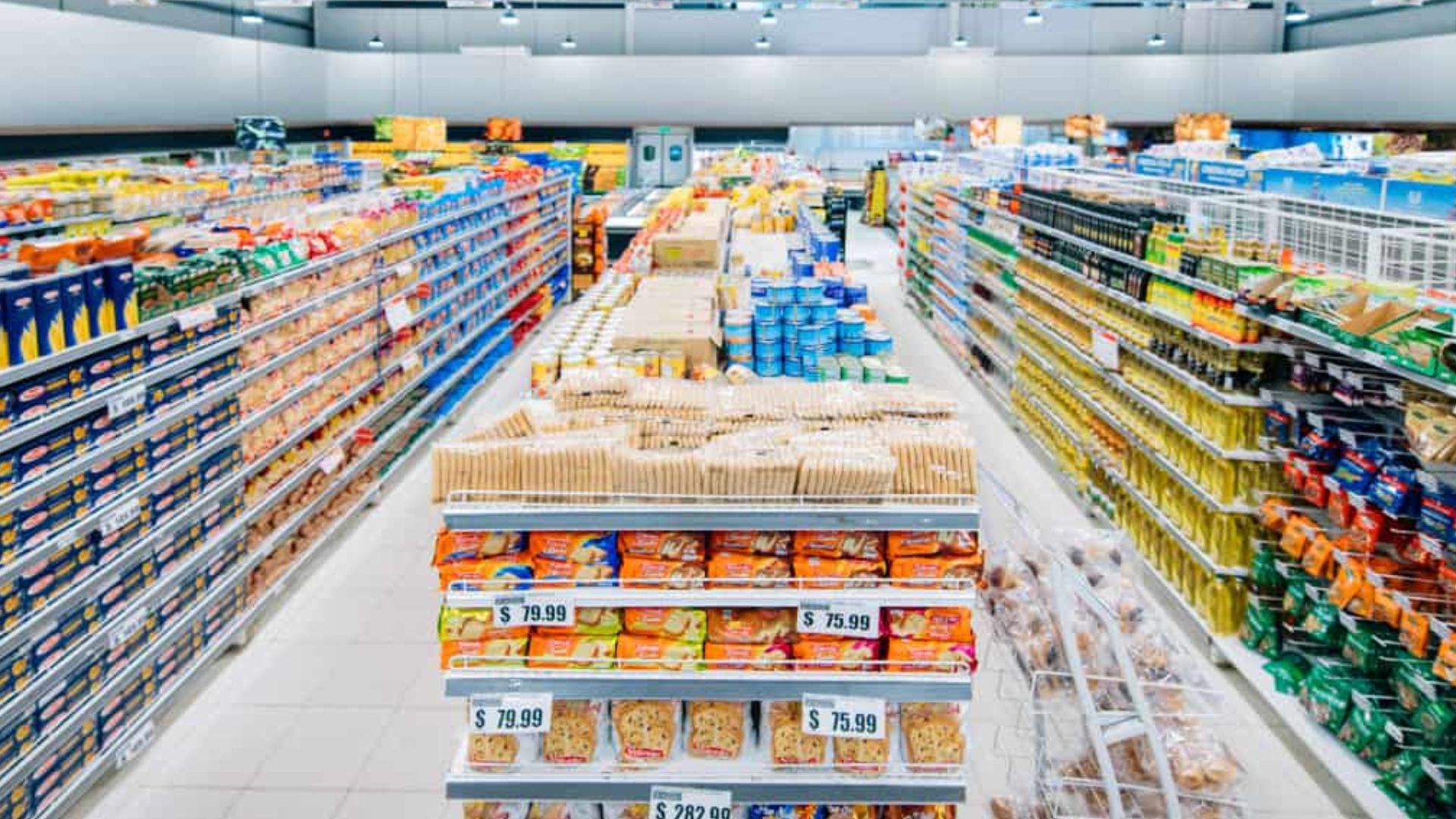Digital transformation in retail is reshaping how CPG brands operate in these environments. Instead of relying only on manual audits or outdated reports, leading brands are using advanced technologies to close the gap between brand strategy and in-store execution.
This retail digital transformation for CPGs isn’t about online shopping or e-commerce; it’s about digitizing how brands monitor and manage their products on physical store shelves. In fact, the global retail digital transformation market is projected to grow from USD 285.76 billion in 2025 to over USD 635 billion by 2030, showing how quickly these solutions are being adopted.
By using these tools, brands can ensure their products are consistently available and optimally placed on shelves.
Key Takeaways:
- Real-Time Shelf Insights: Digital tools give instant visibility into product availability, shelf placement, and promotions, so brands can act quickly.
- Improved Retail Execution: Automating planogram compliance, store audits, and promotion tracking keeps things consistent and maximises brand impact on the shelf.
- Data-Driven Decision Making: Having accurate, real-time in-store data helps CPG brands adjust strategies fast and improve performance.
- Emerging Tech & Trends: AI-driven shelf monitoring, automated compliance, and flexible in-store strategies are shaping the future of retail digital transformation.
What is Retail Digital Transformation for CPG Brands?
Retail digital transformation for CPG brands refers to the adoption of advanced technologies that improve how they monitor and execute their in-store strategies. Tools like image recognition, AI shelf monitoring, and automated compliance tracking help make sure products are stocked, placed, and promoted properly.
This transformation involves digitising audits, planogram checks, and promotion tracking. With these insights, CPG brands can keep products well represented and adjust quickly if something doesn’t go as planned.
What Are Key Elements of Digital Transformation in Retail?
Digital transformation isn’t just one tool; it’s a combination of elements that help CPG brands stay in control of retail execution.

- On-Shelf Stock Visibility: Knowing whether a product is physically available on the shelf is the most important metric for CPGs. Digital solutions capture this data instantly, which reduces lost sales from stockouts.
- Share of Shelf Tracking: Shelf space is finite and competitive. Digitizing the share of shelf tracking lets CPGs see if their products get the visibility they expected, compared to competitors.
- Planogram Compliance Tracking: Planograms dictate where and how products should be placed. Digital tools detect deviations quickly, ensuring stores follow the brand strategy.
- Promotion Compliance: Promotional campaigns are costly and time-bound. Digital solutions ensure that in-store campaigns, like discounts, displays, or bundles, are executed consistently.
- Digitized Store Audits: Instead of lengthy manual store checks, field agents can now capture store conditions with a simple image upload. Automated reporting reduces audit time and allows coverage of more stores.
Together, these elements give brands better visibility and control than manual processes. Nearly 30% of CEOs report revenue gains from advanced technologies, and 45% expect further profit growth this year.
What Are the Benefits of Retail Digital Transformation for CPG Brands?
Adopting digital solutions in retail execution delivers measurable advantages for CPG brands. These benefits help them compete effectively on the shelf.
- Higher On-Shelf Availability: Stockouts are a top reason for lost sales. Real-time shelf monitoring alerts teams when shelves go empty, keeping products available when customers look for them.
- Better Share of Shelf: With digital tracking, brands can ensure they occupy the agreed-upon share of shelf space. This helps sales leaders negotiate better with retailers and plan more effectively.
- Planogram Compliance: Digital transformation ensures that planograms are followed accurately across thousands of stores. This maintains brand consistency and maximises shelf impact.
- Stronger Promotion Execution: By making sure promotions run as planned, brands get better ROI on trade marketing spend and avoid wasted investment.
- Increased Field Force Productivity: Automated shelf monitoring reduces the time field agents spend on manual audits. They can cover more stores per day and focus on fixing issues rather than just reporting.
- Data-Driven Decision Making: Instead of relying on lagging indicators, CPG brands get real-time KPIs, enabling faster action and more agile strategy adjustments.
These benefits ultimately help brands succeed at the shelf, where purchase decisions are made.
What Are Emerging Trends in Retail Digital Transformation?
The retail environment for CPG brands is rapidly evolving, driven by technological advancements and shifting consumer expectations. Here are the key trends shaping this transformation:

- AI-Driven Retail Execution: Artificial Intelligence is revolutionizing in-store operations. It allows real-time shelf monitoring, automated planogram checks, and predictive analytics to improve product placement and availability.
- Store-Level Insights: CPG brands use in-store data to see if products are easy for customers to find and pick up. This helps sales and marketing teams improve execution.
- Sales & Marketing Collaboration: Brands are working closely with retailers to ensure products are displayed effectively, shelves meet standards, and promotions run smoothly across locations.
- Actionable Retail Analytics: Advanced tools provide insights into in-store performance. Sales teams can identify gaps, improve product placement, and boost overall retail execution.
Challenges in Retail Digital Transformation for CPG Brands
Even with its advantages, digital transformation brings challenges for CPG brands when adopting new retail technologies.
- Data Quality and Accuracy: Getting reliable and accurate shelf data requires strong technology and precise models. Without this, transformation efforts can lose credibility.
- Adoption Resistance: Field teams used to manual processes may be hesitant to adopt new digital tools. Proper training and support make adoption smoother.
- Integration Complexities: Integrating new digital solutions with existing systems can be complex and resource-intensive. These challenges might delay the benefits of digital transformation.
- Scalability Across Geographies: Large CPG brands operate in multiple regions with different retail environments. Scaling digital initiatives consistently can be challenging.
- Cost Considerations: Investing in digital platforms and AI tools can be expensive. Brands need to balance costs against the potential for better in-store execution and visibility.
Future Outlook of Retail Digital Transformation
The future of retail execution for CPG brands will be shaped by AI, real-time data, and scalable solutions. This will enable faster and more proactive in-store decision-making.
- Continuous Learning Ecosystem: AI systems will continuously learn from shelf execution patterns, product launches, and seasonal trends to provide smarter, more actionable guidance.
- Faster SKU Adaptation: Tools like rapid AI model training will allow brands to track new products quickly, ensuring visibility and compliance within days of launch.
- Adaptive Shelf Strategies: Stores will no longer follow rigid planograms. Brands can adjust shelf layouts for each region or store type, based on historical shelf execution data for maximum impact.
- Global Scalability: Digital solutions will expand across markets, enabling consistent retail execution across geographies while considering local store variations.
How ParallelDots Supports Retail Digital Transformation for CPG Brands?
ParallelDots empowers CPG brands to navigate the complexities of in-store execution through advanced image recognition technology.
Here’s how it helps:
1. On-Shelf Stock Visibility
ParallelDots’ ShelfWatch captures real-time images of store shelves, allowing sales and marketing teams to instantly identify stockouts. This ensures that products are consistently available on shelves, reducing missed sales opportunities and helping CPG brands maintain optimal presence across thousands of stores.
2. Share of Shelf Tracking
ShelfWatch provides precise measurements of shelf space occupied by a brand versus competitors. CPG teams can monitor visibility across categories, ensuring top-selling SKUs are always prominently displayed, while making data-driven adjustments to improve brand presence where needed.
3. Planogram Compliance Monitoring
Deviations from planograms are a common challenge for CPG brands. ShelfWatch detects these discrepancies in real time, enabling field teams to correct placement errors promptly. This ensures consistent in-store execution aligned with brand strategy and maximizes product impact at the shelf.
4. Promotional Compliance Tracking
Promotional campaigns require precise execution to deliver the expected ROI. ShelfWatch verifies that promotions are implemented as planned, including product positioning and display adherence, helping CPG brands avoid costly mistakes and ensure every store reflects the intended campaign.
5. Rapid SKU Adaptation with Saarthi
ParallelDots’ AI-powered SaaS platform, Saarthi, accelerates AI model training for new or updated SKUs within 48 hours. This allows brands to quickly adapt to product launches or changes in assortment while maintaining over 95% accuracy in shelf-level KPIs, supporting agile retail operations.
By leveraging these solutions, CPG brands can achieve enhanced visibility into in-store execution, leading to improved shelf performance and increased sales opportunities.
Request a demo today to see how ParallelDots can support your brand's digital transformation journey.
Frequently Asked Questions
1. What role do data and predictive analytics play in retail digital transformation?
Data and analytics provide CPG brands with real-time insights into shelf conditions, product placement, and planogram compliance. Predictive analytics help identify potential execution gaps before they occur, allowing field teams to act proactively. This ensures consistent on-shelf visibility, better share of shelf, and effective promotional implementation across physical stores.
2. What digital tools help CPG brands enhance product placement and shelf visibility?
AI-powered tools provide real-time insights into SKU placement, planogram compliance, and share of shelf. These AI-driven platforms allow brands to track on-shelf stock availability across multiple stores, detect gaps or misplacements instantly, and ensure promotional execution. By leveraging such tools, CPG companies can maintain optimal product visibility and improve retail execution efficiency.
3. How can CPG brands leverage digital retail solutions to strengthen brand health tracking?
CPG brands can use AI-powered shelf monitoring to track share of shelf, planogram compliance, and on-shelf availability. Real-time insights from physical stores highlight where products are underperforming or misaligned with placement guidelines. This allows brands to address execution gaps quickly, optimize shelf presence, and maintain consistent visibility—critical indicators of brand health in a competitive retail environment.
4. What does the future of digital transformation in CPG look like?
The future lies in AI-powered, real-time retail execution solutions that give brands full visibility of in-store shelf conditions. CPG companies will increasingly rely on automated shelf monitoring, rapid SKU detection, and compliance tracking to ensure products are correctly placed and visible. Data-driven insights will guide faster decision-making, helping brands maintain market share and optimize physical store performance efficiently.


